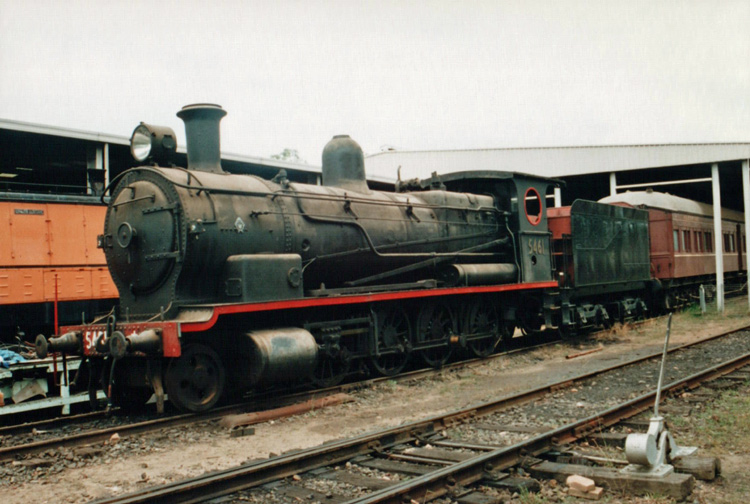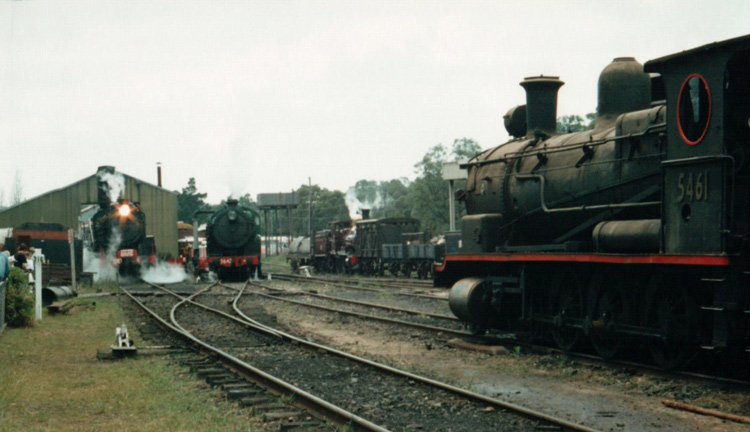|
|
5461 Valley Heights Locomotive Depot Museum |
|

5461 slumbers in the sector house at Valley Heights on 8
October 2006, in company with electric locomotive 4601.
|
Builder |
Granville NSW |
|
Builder’s Number & Year |
210 of 1916 |
|
Wheel Arrangement |
2-8-0 |
|
No. in class |
190 |
|
Standard
Goods engine 5461 was originally issued to traffic as TF 1174 on 14 November
1916 as one of the New South Wales Government Railways’ TF(939)
class 2-8-0 freight locomotives. The TF(939) class was a locally-designed and built development
of the earlier Beyer Peacock & Co designed T(524) class, with changes
including the addition of flanges to all driving wheels (indeed the moniker
TF is ostensibly derived from “T-class with Flanges”). The TF(939) class
were reclassified as (D)53 in the NSWGR 1924 renumbering, with TF 1174
becoming 5461. 190 TF(939)
/ (D)53 locomotives were constructed, 160 by Clyde Engineering and 30 by the
New South Wales Government Railways’ Eveleigh Workshops. Early class members were built with
saturated boilers but 5461 was one of the later deliveries provided with a
superheater. As
built, the TF(939) / D(53) class proved unpopular
with railwaymen, who rechristened the TF’s as “Terrible Failures”. Preserved loco 5461 has an unlikely claim
to fame as engine crews regarded it as the worst of them all; in today’s
parlance it would have been described as a lemon. However the problems with the TF(939) /
(D)53 class engines in general, and 5461 in particular, were overcome in time
and the class settled down to useful main-line freight service. Most of the class were withdrawn and
scrapped in the 1960’s. While 5461 was
condemned on 21 October 1968, it was retained for the collection of the New
South Wales Rail Transport Museum (NSWRTM) at Enfield Depot, Sydney, later
transferring in 1975 to their new site at Thirlmere. 5461
remained an operational exhibit at the NSWRTM during the 1970's and was a
stalwart of the operational fleet in the early 1980’s. (The webmaster has fond memories of this
engine plodding from Sydney Central to Thirlmere on the “Thirlmere Flyer”
trains of the period.) With the return
to service of faster and more powerful steam locomotives 5910 and 3642, 5461
was withdrawn from NSWRTM operational duties in 1985 and placed on static display
at Thirlmere. Change
came in 1996 when 5461 was transferred to the NSWRTM’s outpost in the Blue
Mountains, the Valley Heights Locomotive Depot Museum. I understand that 5461 had been allocated
to the Valley Heights loco depot at one stage during its career; this depot
consists of a sector roundhouse and is situated at the foot of the most
difficult section of the Great Western Railway, providing assistant / banking
engines for west-bound / down trains as they climbed to Katoomba against 1:33
grades and continuous reverse curves of 8-chain radius. While
being prepared for transfer to Valley Heights in 1996, 5461’s Standard Turret
Tender was swapped with the 5595’s “Wampu” 4,000 gallon tender. (Commonwealth Engineering built 201
“Standard Turret Tenders” of 5,000 gallons capacity for the NSWGR in the
1950’s to replace older, life-expired tenders of the 3,650 and 4,000 gallon
“Wampu” types. The Turret Tender
paired with 5461 features two long gouges down the right hand side,
presumably following an accident!) I
understand (from speaking with workshop staff at Thirlmere at the time) the
tender swap was done for operational reasons as there was some consideration
to 5595 being returned to service and the Turret Tender was younger and in
better condition. (While both (D)55
and some D(53) engines operated with Wampu tenders, the original tender
pairing perhaps better reflects the more usual historical pairing and hence the
two tenders could one day be swapped back, with the Wampu tender returned to
Thirlmere for display behind 5595.) 5461
has been statically displayed on one of the roundhouse roads at Valley
Heights since 1996 and has been well cared for by the volunteer workers
there. During 2008 its old boiler
lagging was removed at Valley Heights by specialist contractors. The boiler clothing has since been replaced
and 5461 has received a quality cosmetic restoration by the volunteers at
Valley Heights. As
an aside, a spare (D)53 class boiler (Tab 5476A) is
also held in store by the NSWRTM Thirlmere. For more
general information about the TF(939) / (D)53 class,
refer to the entry for 5353. |

This circa-1984 photo is
courtesy of John Hurst and shows
5461 paused on a special train near Bowral, in the NSW Southern Highlands.
5461’s Standard Turret Tender is prominent in this view,
with the Commonwealth Engineering builder’s plate central to the tank.

A nice view of 5461
heading south on the Illawarra line and about to enter the Kiama tunnel.
This photo is via the collection of John
Hurst and dated August 1973.

The following series of
scanned photos show 5461 at Thirlmere on 3 March 1996.
It had recently been
paired with 5595's Wampu tender in preparation for rail haulage to Valley
Heights.

5461 looks on during the
action at the NSWRTM Festival of steam on 3 March 1996.
5910 is on the loco shed
road, 3642 is on the arrival road while 1709 is stabled with the demonstration
freight train.

A further view of 5461
at Thirlmere on 3 March 1996; this view shows the high capacity “Wampu” bogie
tender, the only survivor of this type.
The Wampu tenders were
supplied with the (D)55 class to provide extended range
for main-line freight duties.
While both (D)55 and some D(53) engines operated with Wampu
tenders, the type is perhaps better remembered behind the D(55)’s such as 5595.

The plate is stamped ‘No.69’
with the build date ‘14 October 1953’.
References
|
a |
‘Standards
in Steam – the 53 & 55 Class’ by R. G. Preston, Published
by Eveleigh Press, 2000. |
|
b |
‘A
Compendium of New South Wales Steam Locomotives’ compiled by Alex Grunbach, published by the Australian
Railway Historical Society, New South Wales Division, 1989. |
|
c |
‘Steam
Locomotive Data’ July 1974 edition, compiled by J. H. Forsyth for the Public
Transport Commission of NSW. |
|
d |
Wikipedia
entry for the NSWGR D53 class, retrieved 16 June 2015. |
|
e |
Webmaster's
observation or comment |
Page updated:
2 February 2016
|
Government Railways: |
|
|||||||||
|
Private & Industrial Railways: |
|